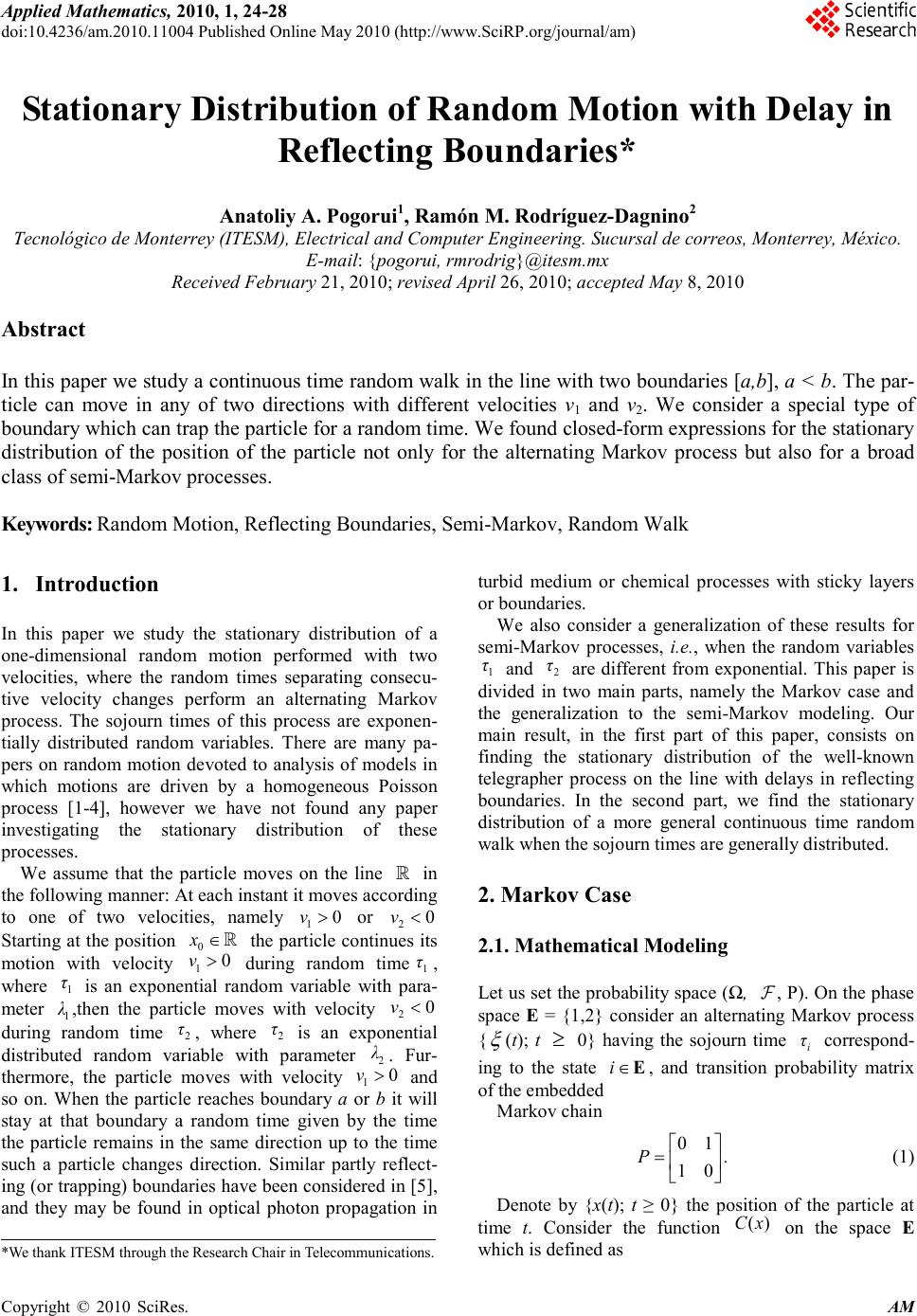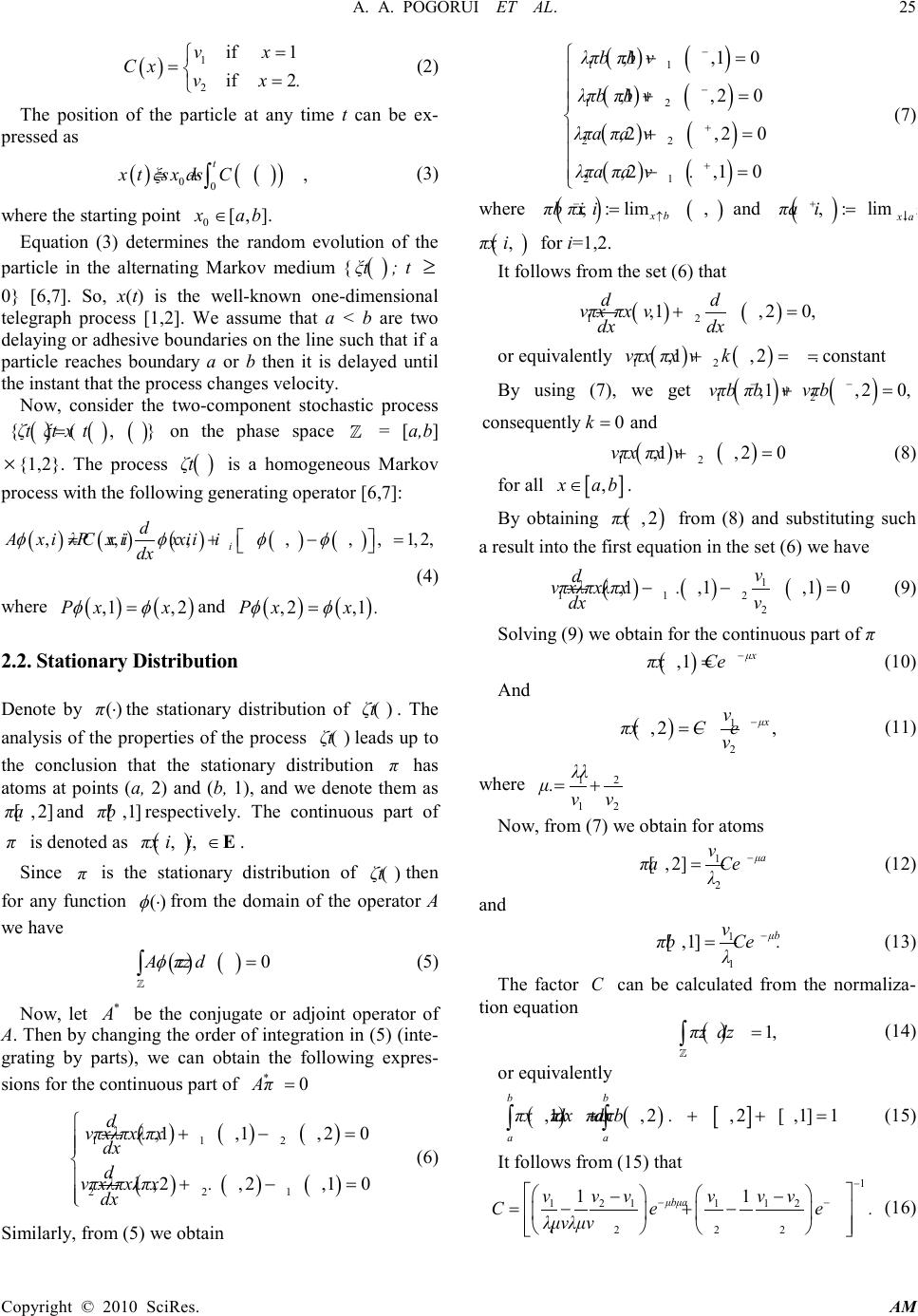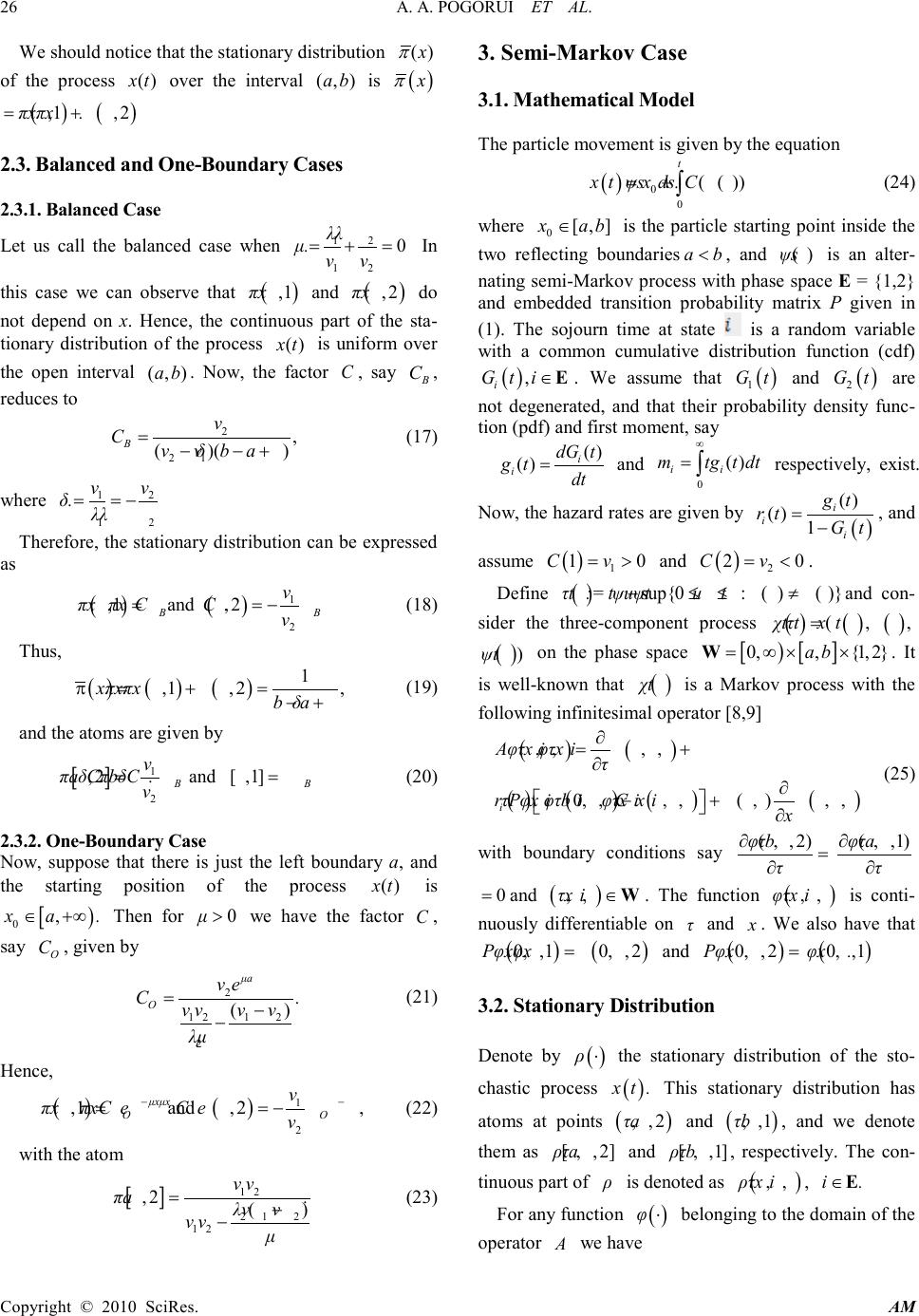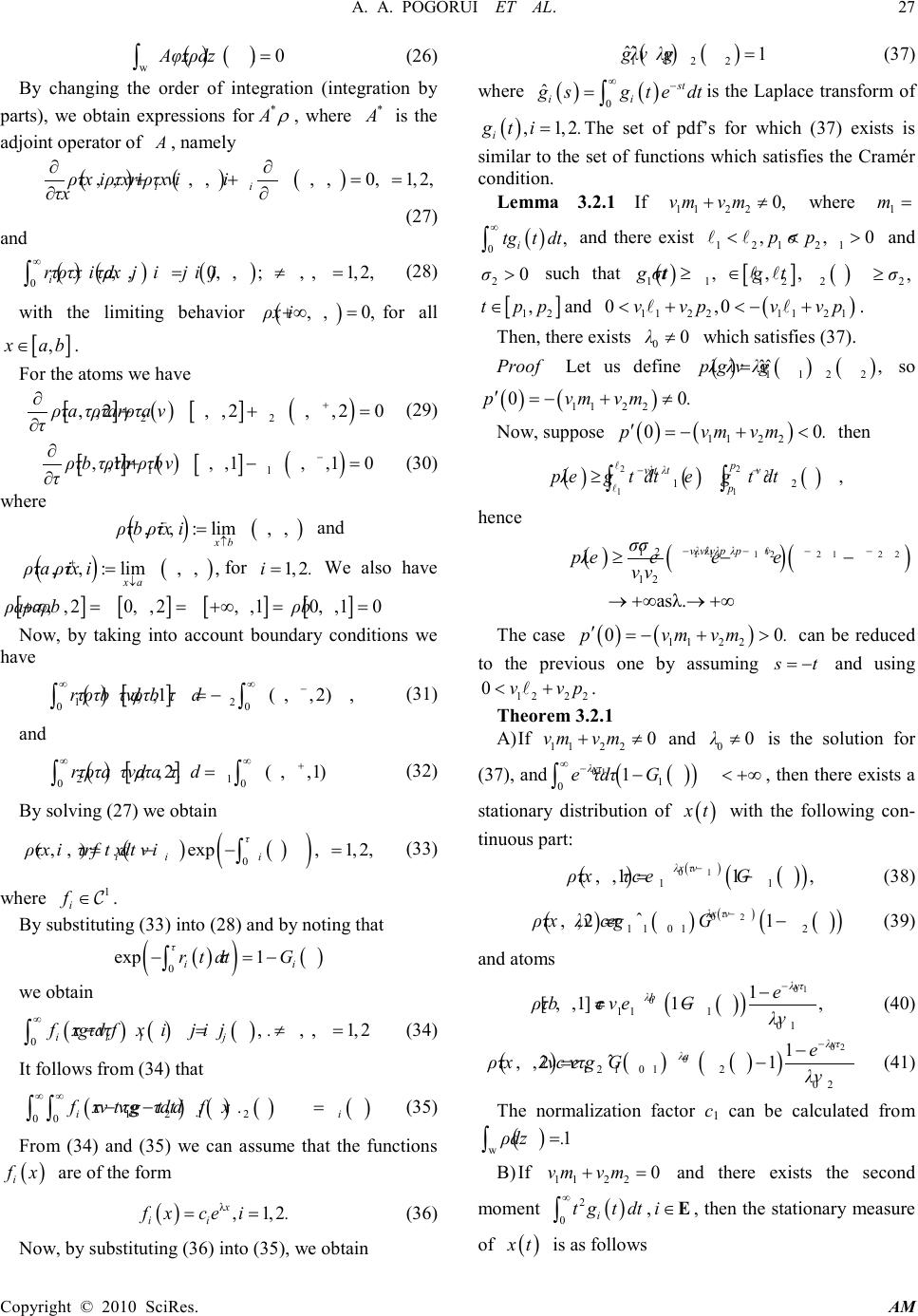Paper Menu >>
Journal Menu >>
 Applied Mathematics, 2010, 1, 24-28 doi:10.4236/am.2010.11004 Published Online May 2010 (http://www.SciRP.org/journal/am) Copyright © 2010 SciRes. AM Stationary Distribution of Random Motion with Delay in Reflecting Boundaries* Anatoliy A. Pogorui1, Ramón M. Rodríguez-Dagnino2 Tecnológico de Monterrey (ITESM), Electrical and Computer Engineering. Sucursal de correos, Monterrey, México. E-mail: {pogorui, rmrod rig }@itesm.mx Received February 21, 2010; revised April 26, 2010; accepted May 8, 2010 Abstract In this paper we study a continuous time random walk in the line with two boundaries [a,b], a < b. The par- ticle can move in any of two directions with different velocities v1 and v2. We consider a special type of boundary which can trap the particle for a random time. We found closed-form expressions for the stationary distribution of the position of the particle not only for the alternating Markov process but also for a broad class of semi-Markov processes. Keywords: Random Motion, Reflecting Boundaries, Semi-Markov, Random Walk 1. Introduction In this paper we study the stationary distribution of a one-dimensional random motion performed with two velocities, where the random times separating consecu- tive velocity changes perform an alternating Markov process. The sojourn times of this process are exponen- tially distributed random variables. There are many pa- pers on random motion devoted to analysis of models in which motions are driven by a homogeneous Poisson process [1-4], however we have not found any paper investigating the stationary distribution of these pro ce sses. We assume that the particle moves on the line in the following manner: At each instant it moves according to one of two velocities, namely 1 0v> or 2 0v< Starting at the position 0 x∈ the particle continues its motion with velocity 10v> during random time 1 τ , where 1 τ is an exponential random variable with para- meter 1 λ ,then the particle moves with velocity 2 0v< during random time 2 τ , where 2 τ is an exponential distributed random variable with parameter 2 λ . Fur- thermore, the particle moves with velocity 1 0v> and so on. When the particle reaches boundary a or b it will stay at that boundary a random time given by the time the particle remains in the same direction up to the time such a particle changes direction. Similar partly reflect- ing (or trapping) boundaries have been considered in [5], and they may be found in optical photon propagation in turbid medium or chemical processes with sticky layers or boundaries. We also consider a generalization of these results for semi-Markov processes, i.e., when the random variables 1 τ and 2 τ are different from exponential. This paper is divided in two main parts, namely the Markov case and the generalization to the semi-Markov modeling. Our main result, in the first part of this paper, consists on finding the stationary distribution of the well-known telegrapher process on the line with delays in reflecting boundaries. In the second part, we find the stationary distribution of a more general continuous time random walk when the sojourn times are generally distributed. 2. Markov Case 2.1. Mathematical Modeling Let us set the probability space (Ω, , P). On the phase space E = {1,2} consider an alternating Markov process { ξ (t); t ≥ 0} having the sojourn time i τ correspond- ing to the state i∈E , and transition probability matrix of the embedded Markov chain 01 10 P. = (1) Denote by {x(t); t ≥ 0} the position of the particle at time t. Consider the function ()Cx on the space E whi ch is defined as * We thank ITESM through the Research Chair in Telecommunications.  A. A. POGORUI ET AL. 25 Copyright © 2010 SciRes. AM ( ) 1 2 if 1 if 2 vx Cx v x. = == (2) The position of the particle at any time t can be ex- pressed as ( )() ( ) 00, t xt xCξs ds=+ ∫ (3) where the starting point 0[ ,].x ab∈ Equation (3) determines the random evolution of the particle in the alternating Markov medium { ( ) ξt ; t ≥ 0} [6,7]. So, x(t) is the well-known one-dimensional telegraph process [1,2]. We assume that a < b are two delaying or adhesive boundaries on the line such that if a particle reaches boundary a or b then it is delayed until the instant that the process changes velocity. Now, consider the two-component stochastic process ( )( )( ) { (, }ζt xtξt= on the phase space = [a,b] × {1,2}. The process ( ) ζt is a homogeneous Markov process with the following generating operator [6,7]: ( )( )( )( )( ) ,,,,,,1, 2, i d AxiC xixiλP xixii dx φφ φφ =+ −= (4) where ( )() ,1 ,2Px x φφ = and ()( ) ,2 ,1Px x. φφ = 2.2. Stationary Distribution Denote by ()π⋅ the stationary distribution of ()ζt . The analysis of the properties of the process ()ζt leads up to the conclusion that the stationary distribution π has atoms at points (a, 2) and (b, 1), and we denote them as [,2]πa and [ ,1]πbrespectively. The continuous part of π is denoted as ( ) ,,πxii ∈E . Since π is the stationary distribution of ()ζt then for any function () φ ⋅ from the domain of the operator A we have ( )( ) 0A zdπz φ = ∫ (5) Now, let * A be the conjugate or adjoint operator of A. Then by changing the order of integration in (5) (inte- grating by parts), we can obtain the following expres- sions for the continuous part of 0 * Aπ= ( )( )() ( )( )() 1 12 2 21 ,1,1,20 ,2,2,10 +− = + −= d vπxλπxλπx dx d vπxλπxλπx. dx (6) Similarly, from (5) we obtain ( ) ( ) ( ) () ( ) ( ) ( ) ( ) 11 12 22 21 ,1,10 ,1,2 0 ,2,2 0 ,2,1 0 λπbvπb λπbvπb λπavπa λπavπa. − − + + −= += += −= (7) where ( ) ( ) ,: lim, xb πbiπxi − ↑ = and ( ) ,:πai + = lim xa π ↓ ( ) ,πxi for i=1,2. It follows from the set (6) that ( )() 12 ,1, 20, dd vπxvπx dx dx += or equivalently ( )() 12 ,1,2constantvπxvπxk .+== By using (7), we get ( ) 1 ,1vπbvπb − + ( ) 2 , 20,v πb − = consequently0 andk= ( )() 12 ,1,2 0vπxvπx+= (8) for all [ ] ,x ab∈ . By obtaining ( ) ,2πx from (8) and substituting such a result into the first equation in the set (6) we have ( )( )( ) 1 1 12 2 ,1,1,1 0−− = v d vπxλπxλπx. dx v (9) Solving (9) we obtain for the continuous part of π ( ) ,1 μx πx Ce − = (10) And ( ) 1 2 ,2 , μx v πx Ce v − = − (11) where 12 12 λλ μ. vv = + Now, from (7) we obtain for atoms 1 2 [, 2] − = μa v πa Ce λ (12) and 1 1 [ ,1]− =μb v πbCe . λ (13) The factor C can be calculated from the normaliza- tion equation ( ) 1,πz dz= ∫ (14) or equivalently ( )() [ ] ,1,2,2[,1]1 bb aa πx dxπx dxπaπb.+++= ∫∫ (15) It follows from (15) that 1 1 211 12 12 22 11 − −− −− = −+− μbμa v vvvvv C ee. λμvλμv (16)  26 A. A. POGORUI ET AL. Copyright © 2010 SciRes. AM We should notice that the stationary distribution ()x π of the process ()xt over the interval (,) ab is ( ) x π ( )() ,1 ,2πxπx.= + 2.3. Balanced and One-Boundary Cases 2.3.1. Balanced Case Let us call the balanced case when 12 12 0 λλ μ.vv =+= In this case we can observe that ( ) ,1πx and ( ) ,2πx do not depend on x. Hence, the continuous part of the sta- tionary distribution of the process ()xt is uniform over the open interval (,) ab . Now, the factor C , say B C , reduces to 2 21 , ( )() B v Cv vbaδ =− −+ (17) where 12 12 vv δ.λλ == − Therefore, the stationary distribution can be expressed as ( )() 1 2 ,1and, 2 BB v πxCπxC. v == − (18) Thus, ( )()() 1 ,1 ,2,xπxπxbaδ =+= −+ π (19) and the atoms are given by [ ] 1 2 ,2and [,1] BB v πaδCπbδC. v = = (20) 2.3.2. One-Boundary Case Now, suppose that there is just the left boundary a, and the starting position of the process ()xt is [ ) 0 ,xa .∈ +∞ Then for 0μ> we have the factor C , say O C , given by 2 121 2 2 () μa O ve C. vvv v λμ =− − (21) Hence, ( )() 1 2 ,1and ,2, μxμx OO v πx Ceπx Cev −− == − (22) with the atom [ ] 12 21 2 12 ,2 () =− − vv πa. λvv vv μ (23) 3. Semi-Markov Case 3.1. Mathematical Model The particle movement is given by the equation ( ) 0 0 (( )) t xt xCψs ds.= + ∫ (24) where 0 [,] x ab∈ is the particle starting point inside the two reflecting boundaries ab< , and ()ψs is an alter- nating semi-Markov process with phase space E = {1,2} and embedded transition probability matrix P given in (1). The sojourn time at state is a random variable with a common cumulative distribution function (cdf) ( ) , i Gt i∈E . We assume that ( ) 1 Gt and ( ) 2 Gt are not degenerated, and that their probability density func- tion (pdf) and first moment, say () () i i dG t gt dt = and 0 () ii mtgtdt ∞ =∫ respectively, exist. Now, the hazard rates are given by ( ) () () 1 i i i gt rt Gt =− , and assume ( ) 1 10Cv= > and ( ) 2 20Cv= < . Define ( ) sup{0:()( )}τt:=tutψuψt−≤≤≠ and con- sider the three-component process ( )( )( ) (, ,χtτt xt= ( ) )ψt on the phase space [ ) [ ] 0 ,,{1,2}ab=∞××W . It is well-known that ( ) χt is a Markov process with the following infinitesimal operator [8,9] ( )( ) ( )()()( ) ,, ,, 0,,,, (,),, i Aφτxiφτxi τ rτPφxiφτbiC xiφτxi x ∂ = + ∂ ∂ −+ ∂ (25) with boundary conditions say (,, 2)φτb τ ∂= ∂ ( ,,1)φτa τ ∂ ∂ 0= and ( ) ,,τxi∈W . The function ( ) ,,φτxi is conti- nuously differentiable on τ and x . We also have that () () 0, ,10, ,2Pφxφx= and ( ) 0,,2Pφx= ( ) 0, ,1φx. 3.2. Stationary Distribution Denote by ( ) ρ⋅ the stationary distribution of the sto- chastic process ( ) xt. This stationary distribution has atoms at points ( ) , ,2τa and ( ) , ,1τb , and we denote them as [,, 2]ρτa and [ ,,1]ρτb , respectively. The con- tinuous part of ρ is denoted as ( ) ,,ρτxi , i.∈E For any function ( ) φ⋅ belonging to the domain of the operator A we have  A. A. POGORUI ET AL. 27 Copyright © 2010 SciRes. AM ( )() w 0Aφzρdz. = ∫ (26) By changing the order of integration (integration by parts), we obtain expressions for * A ρ , where * A is the adjoint operator of A , namely ()() () ,,,,,,0,1,2, ii ρτxirρτxi vρτxii τx ∂∂ ++ == ∂∂ (27) and ( )()() 0 , ,0, ,;,,1,2, i rτρτxi dτρx jiji j ∞ = ≠= ∫ (28) with the limiting behavior ( ) , ,0,ρxi+∞ = for all [ ] ,x ab∈ . For the atoms we have [ ] ( ) [ ] ( ) 22 , ,2, ,2,,20ρτarτρτavρτa τ + ∂+ += ∂ (29) [ ] ( ) [ ] () 11 , ,1, ,1,,10ρτbrτρτbvρτb τ − ∂+ −= ∂ (30) where ( ) ( ) ,,:lim, , xb ρτbiρτxi − ↑ = and ( ) ( ) ,,:lim, ,, xa ρτaiρτxi + ↓ =for 1, 2i.= We also have [] [][] , ,20, ,2,,1ρaρaρb+∞== +∞= [ ] 0, ,10ρb= Now, by taking into account boundary conditions we have ( ) [ ] 12 00 ,,1( ,,, 2)rτρτbdτvρτbdτ ∞∞ − = −∫∫ (31) and ( ) [ ] 21 00 ,,2(,,1)rτρτad τvρτadτ. ∞∞ + = ∫∫ (32) By solving (27) we obtain ( ) ( ) () 0 (,,)exp,1, 2, τ ii i ρτxif xvτrtdti=−− = ∫ (33) where 1 i f∈ . By substituting (33) into (28) and by noting that ( ) () ( ) 0 exp 1 τ ii rtdtGτ−=− ∫ we obtain ( ) ( )() 0 ,,,1, 2 i iij fxvτgτdτfxiji j. ∞ −=≠= ∫ (34) It follows from (34) that ()()( )() 1 212 00 ii fxvτvt gτg tdτdtfx . ∞∞ −− = ∫∫ (35) From (34) and (35) we can assume that the functions ( ) i fx are of the form ( ) λ,1,2 x ii f xcei.= = (36) Now, by substituting (36) into (35), we obtain () () 1 122 ˆˆ 1=gλvgλv (37) where ()( ) 0 ˆ st ii gsgtedt ∞− =∫ is the Laplace transform of ( ) ,1, 2 i gti .= The set of pdf’s for which (37) exists is similar to the set of functions which satisfies the Cramér condition. Lemma 3.2.1 If 112 20,vm vm+≠ where 1 m= ( ) 0 , i tgtdt ∞ ∫ and there exist 12121 , ,0ppσ<< > and 20σ> such that ( ) [ ] ( ) 1112 2 , ,,gtσt gt≥∈ 2,σ≥ [ ] 12 ,t pp∈ and ( ) 11 2211 21 0 ,0v vpv vp< +<−+ . Then, there exists 0 0λ≠ which satisfies (37). Proof Let us define ( )()() 1 122 ˆˆ ,pλgλvgλv= so ( )() 112 2 00pvmvm. ′=−+ ≠ Now, suppose ( )() 112 2 00pvmvm. ′=−+ < then ()( )( ) 22 12 11 12 , p vλtvλt p pλegt dtegt dt −− ≥ ∫∫ hence ( ) ( )() 1112212 2 12 12 asλ. vλvλvλpvλp σσ pλeeee vv −− − − ≥− − → +∞→+∞ The case ( )() 112 2 00pvm vm. ′=−+ > can be reduced to the previous one by assuming st= − and using 122 2 0v vp<+ . Theorem 3.2.1 A) If 112 20vm vm+≠ and 0 0λ≠ is the solution for (37), and ( ) ( ) 01 1 0 1 λvτ eGτdτ ∞− −<+∞ ∫ , then there exists a stationary distribution of ( ) xt with the following con- tinuous part: ( ) ( ) ( ) ( ) 01 11 , ,11, λxvτ ρτx ceGτ − = − (38) ( ) ( ) ( ) ( ) ( ) 02 1 1012 ˆ , ,21 − = − λxvτ ρτx cgλveGτ (39) and atoms ( ) ( ) 01 0 11 1 01 1 [ ,,1]1, λvτ λbe ρτbcveGτλv − − = − (40) ( ) ( ) ( ) ( ) 02 0 12 1012 02 1 ˆ , ,21 − − = − λvτ λa e ρτxcv gλve Gτ.λv (41) The normalization factor c1 can be calculated from ( ) w 1ρdz .= ∫ B) If 112 2 0vm vm+= and there exists the second moment ( ) 2 0i t gt dt ∞ ∫ , i∈E , then the stationary measure of ( ) xt is as follows  28 A. A. POGORUI ET AL. Copyright © 2010 SciRes. AM ()( ) ( ) ()() ( ) 21 22 ,,11, ,,21ρτxcGτρτx cGτ=−=− (42) with atoms [ ] ( ) ( ) [ ] ( ) ( ) 21122 2 , ,11,, ,21ρτb cvτGτρτa cvτGτ=−=− (43) whe re ( ) 1 (2) (2) 12 2 1212 () 22 mm cm m bavv. − = +−+− Proof It is easy to see that ( ) 0 λ 11 x f xce= and ( ) ( ) 0 21101 ˆ = λx f xcgλve satisfy (34). Substituting these functions fi into (33) we obtain (38) and (39). Therefore we substitute (38) and (39) into (29) and (30), then by solving these equations we obtain (40) and (41). It can be easily verified that if 112 2 0vm vm+≠ then the value 00,λ≠ such that () () 1 01202 ˆˆ 1,=gλvgλv also satisfies (31) and (32). Similarly, for 112 2 0vm vm+= we obtain (42) and (43) in the same manner as for the case 112 2 0vm vm+≠ when it is considered that 0 0λ.= We should notice that the stationary measure of the particle position ( ) xt is determined by the following relations ( )()() ( ) ( ) 0 ,,1,,2,for ,,ρxρτxρτxdτx ab ∞ =+∈ ∫ (44) [][][][] 00 ,2,,2,,1, ,1ρaρτadτρbρτbdτ. ∞∞ = = ∫∫ (45) Example Markov Case Suppose ( ) ,0,1, 2;0 i λt i ii gtλeλit. − =>= ≥ The n, () () 12 1 012 02 1 01202 ˆˆ 1 λλ gλvgλv. λλvλλv = = −− Therefore, 12 0 12 , λλ λvv = + and this case is the same as the one in the first part of this paper. Example Erlang Case Let ( )( ) 1 2 1 121 ,,0, 0, λtpt gtλegtpteλp −− ==>> and 0t.≥ Then, ()() 2 1 1 012 02 1 0102 ˆˆ 1, = = −− λp gλvgλvλλvpλv (46) where we have the conditions 1 0102 an d λλvpλv.>> Now, by solving (46) and taking into account the pre- vious conditions, we obtain a unique solution for (46) ()( ) 2 12112 11 0 12 24 2 λvpvv vpλpλ λvv − ++−+ =− Since ( )( ) 2 2 11 0, ,, 1 pt rtpas tand rtλ pt =→>→+∞= + then the Theorem 3.2.1 is applicable. 4. Conclusions The two-state continuous time random walk has been studied by many researchers for the Markov case and only a few have studied for non-Markovian processes [10]. This basic model has many applications in physics, biology, chemistry, and engineering. Most of the former models were oriented to solve the boundary-free particle motion. Recently this basic model has been extended in several directions, such as two and three dimensions, with reflecting and absorbing boundaries. Only a few of these works consider partly reflecting boundaries [5,10], and references therein. However, in none of these pre- vious works a stationary distribution for the particle po- sition is presented, as we did in this paper. We have in- cluded the Markov case since it is illustrative and it mo- tivates our analysis of the semi-Markov process. 5. Referen ces [1] S. Goldstein, “On Diffusion by Discontinuous Move- ments and on the Telegraph Equation,” The Quarterly Journal of Mechanics and Applied Math ematics, Vol. 4, No. 2, 1951, pp. 129-156. [2] M. Kac, “A Stochastic Model Related to the Telegraph- er’s Equation,” Rocky Mountain Journal of Mathematics, Vol. 4, No. 3, 1974, pp. 497-509. [3] E. Orsingher, “Hyperbolic Equations Arising in Random Models,” Stochastic Processes and their Applications, Vol. 21, No. 1, 1985, pp. 93-106. [4] A. F. Turbin, “Mathematical Model of Einstein, Wiener, Levy,” in Russian, Fractal Analysis and Related Fields, Vol. 2, 1998, pp. 47-60. [5] J. Masoliver, J. M. Porrà, and G. H. Weiss, “Solution to the Telegrapher’s Equation in the Presence of Reflecting and Partly Reflecting Boundaries,” Physical Review E, Vol. 48, No. 2, 1993, pp. 939-944. [6] V. S. Korolyuk and A. V. Swishchuk, A. V. Semi- Mar- kov, “Random Evolutions,” Kluwer Academic Publishers, 1995. [7] V. S. Korolyuk and V. V. Korolyuk, “Stochastic Models of Systems,” Kluwer Academic Publishers, 1999. [8] V. S. Korolyuk and A. F. Turbin, “Mathematical Founda- tions of the State Lumping of Large Systems,” Kluwer Academic Publishers, 1994. [9] I. I. Gikhman and A. V. Skorokhod, “Theory of Stochas- tic Processes, Vol. 2,” Springer-Verlag, New York, 1975. [10] V. Balakrishnan, C. van den Broeck and P. Hangui, “First-Passage of Non-Markovian Processes: The Case of a Reflecting Boundary,” Physical Review A, Vol. 38, No. 8, 1988, pp. 4213-4222. |

